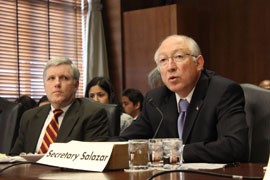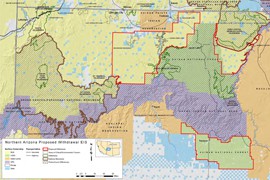Cronkite News has moved to a new home at cronkitenews.azpbs.org. Use this site to search archives from 2011 to May 2015. You can search the new site for current stories.
Salazar confident uranium-mining ban will withstand legal challenge
WASHINGTON – Interior Secretary Ken Salazar said Tuesday he is confident a 20–year ban on uranium mining near the Grand Canyon will hold up to an industry lawsuit challenging the January withdrawal of the land by federal officials.
Salazar’s comments came one day after the National Mining Association and the Nuclear Energy Institute filed suit U.S. District Court in Arizona, arguing that the Department of the Interior cannot withdraw more than 5,000 acres of land at a time under the law it cited.
But Salazar said prohibiting uranium mining on a million acres of public land near the natural landmark was the right decision and a legally defensible decision.
“I feel very confident in our decision, and I think it’ll withstand any legal challenge that is being made,” he said in comments after addressing the Senate Energy and Natural Resources Committee.
Uranium mining near the Grand Canyon could impact the Colorado River, and the 20–year ban “will allow us to develop the science relative to uranium mining,” he said.
“That’s important for the 30–million–plus people who depend on the water supply from the Colorado River,” Salazar said.
The lawsuit argues that the government withdrew the land using a provision in the Federal Land Policy and Management Act similar to another provision that was ruled unconstitutional by the Supreme Court in 1983, said Carol Raulston, spokeswoman for the mining association.
“The secretary’s million–acre land withdrawal is constitutionally invalid,” mining association President Hal Quinn said in a prepared statement.
The two organizations also claimed that Interior’s environmental assessment fails to support its decision to withdraw so much land. The withdrawal is based on practices and standards that no longer exist, said Richard Myers, NEI vice president for policy development in a prepared statement.
“It is a mistake to judge today’s uranium mining activities by practices and standards from 50 to 60 years ago,” his statements said. “Yet that, apparently, is what the Interior Department has done in its final environmental impact statement.”
But environmentalists came to the defense of the ban and said Tuesday they were glad to hear of Salazar’s confidence that it will hold up.
“We’ve always thought that this was something the Department of the Interior could do and should do,” said Sandy Bahr, director of the Grand Canyon Chapter of the Sierra Club. “So it’s good to know that the secretary is confident in it and those lands will be protected.”
Bahr said the mining industry is used to getting its way when it comes to public lands, and she believes that is one reason for Monday’s lawsuit.
“The mining industry seems to forget that these are public lands, not their lands,” she said. “There are more important things than their short–term profits – namely the Grand Canyon.”
Environmentalists also said they do not believe the department’s environmental analysis will be found to be flawed as it spent more than two years on research, analysis and review of “hundreds of thousands of comments in support of the withdrawal,” Bahr said.
Uranium mining could lead to groundwater pollution, damage to cultural resources that are important to tribes and harm to wildlife, said Ted Zukoski, staff attorney for Earthjustice.
“This is the iconic landscape of Arizona if not the American West,” Zukoski said. “A go–slow approach makes sense instead of a pell–mell gold rush.”








